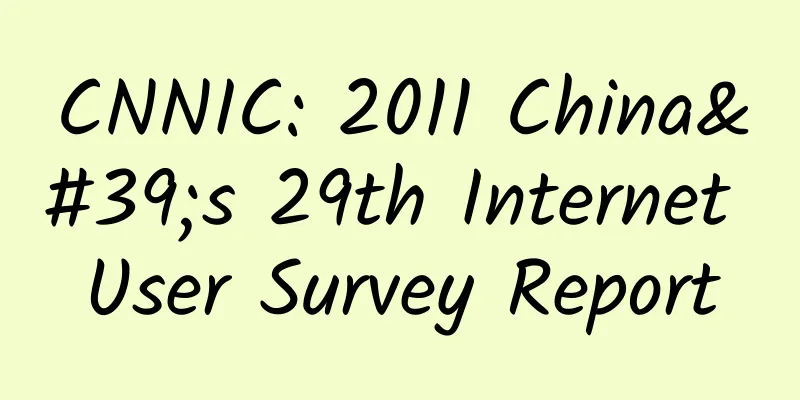CNNIC: 2011 China's 29th Internet User Survey Report

|
1. Overall Internet Application Status In 2011, the Internet application habits of Chinese netizens changed significantly. New Internet applications, including new instant messaging and microblogs, spread rapidly. At the same time, the usage rate of some traditional network applications declined significantly, showing the rapid development and innovation of the Internet. The changes in the characteristics of Internet application of Chinese netizens can be summarized as follows: The way netizens communicate on the Internet has changed significantly In 2011, the usage rate of instant messaging among Chinese netizens increased rapidly, reaching 80.9%. At the same time, the user scale of many traditional communication applications shrank: the usage rate of email dropped from 54.6% in 2010 to 47.9%, and the number of users decreased by 3.92 million; the number of forums/BBS dropped from 32.4% to 28.2%, and the number of users also decreased slightly. After a significant decline in the usage rate of social networking sites in the first half of this year, the number of users improved in the second half of the year, and the current usage rate has stabilized and reached 47.6%. The above data shows that the habits and methods of netizens' communication and interaction through the Internet are quite different from before. Entertainment applications generally declined, but online video users increased significantly The usage rate of most online entertainment applications continued to decline in 2011. The user scale of online music, online games and online literature increased slightly in 2011, and the usage rate also dropped to 75.2%, 63.2% and 39.5% respectively. In contrast, the development momentum of the online video industry is relatively good, with the user scale increasing by 14.6% year-on-year to 325 million people, and the usage rate increased to 63.4%. The usage rate of e-commerce applications continues to rise E-commerce applications have developed steadily, and the user scale of online shopping, online payment, online banking and online travel booking applications has increased across the board. Compared with 2010, the number of online shopping users increased by 33.44 million, a growth rate of 20.8%, and the utilization rates of online payment and online banking also increased to 32.5% and 32.4%. In addition, group buying became the second fastest growing network service throughout the year, with an annual user growth rate of 244.8%, a user scale of 64.65 million, and a utilization rate of 12.6%. Table 7 Utilization rate of various network applications in 2010-2011(I) Information Acquisition 1. Search Engines By the end of 2011, the number of search engine users reached 407 million, with a penetration rate of 79.4% among Internet users. The usage ratio remained basically stable, making it the second largest Internet application after instant messaging in 2011. Figure 20 Number of search engine users and usage rate, 2010-20112. Online News The usage rate of online news has been declining year after year, from 80.1% at the end of 2009 to 71.5% at the end of 2011, a drop of 8.6 percentage points in two years. According to the results of the 29th CNNIC survey, there is a strong correlation between education level and the rate of online news usage. The lower the education level, the lower the rate of online news usage. The rate of online news usage among netizens with a college degree is 87.6%, while the rate of online news usage among netizens with a junior high school degree is only 62.1%. China's Internet has gone through the stage of popularization among highly educated people. The penetration rate of netizens with a college degree or above has exceeded 90%. The Internet is spreading to people with high school and junior high school education. The increase in the number of people with low education has lowered the overall rate of online news usage among netizens. Figure 21 Number of online news users and usage rate, 2010-2011(II) Business Transactions 1. Online shopping By the end of December 2011, the number of online shopping users in my country reached 194 million, and the online shopping utilization rate increased to 37.8%. Compared with 2010, the number of online shopping users increased by 33.44 million, a growth rate of 20.8%. Under the background of the country's efforts to boost domestic demand and stimulate social consumption, the deepening of online shopping services has driven more netizens to realize their daily consumption through online shopping. The frequent promotions of shopping websites have also stimulated new purchasing needs of netizens, driving the steady growth of the scale of online shopping users. In 2011, brand enterprises and platform malls (B2C) have become the absolute main body of the market, and the share of traditional manufacturers and channel merchants in the online shopping market has increased significantly. The derivative enterprises promoted by online shopping transactions have prospered and developed, and the types of goods and services traded online have become more abundant, driving a significant increase in the frequency and amount of online shopping by users. While the online shopping market maintained a steady and rapid development throughout the year, it also faced some prominent problems. The slow improvement of logistics and distribution service capabilities hindered the acceleration of e-commerce services; low-price competition in the market became the norm, and merchants were not profitable enough; the capital market was cold, and the subsequent development support was worrying; the leakage of user information on shopping websites weakened consumer trust, etc. These problems have become important factors restricting the sustained and rapid development of the online retail market. With the government's significantly increased support and regulation of the online retail market, the issuance of third-party payment licenses, the formulation of logistics service development plans, and the preparation and release of online shopping regulatory management regulations, the online shopping market will usher in a more standardized industry development environment in the future. While the scale of online shopping companies is growing, they need to shift from extensive development to refined excavation, from expansion to depth, to achieve a comprehensive improvement in the overall service level of the online shopping industry. Figure 22 Number of online shopping users and usage rate in 2010-20112. Group buying By the end of December 2011, the number of group buying users in my country reached 64.65 million, and the utilization rate increased to 12.6%, up 8.5 percentage points from the end of 2010. The annual growth rate of group buying users was as high as 244.8%, making it the second fastest growing network service throughout the year. In 2011, online group buying was hot first and then cold. As the group buying service caters to the consumption needs of white-collar workers in first- and second-tier cities, the number of group buying users and service providers increased rapidly in the first half of the year, and the industry continued to be hot. However, the group buying service itself had problems such as low threshold and weak constraints, and the group buying websites had invested a lot of money in the early stage, and encountered the overall cooling of the capital market. The negative market factors began to appear in the second half of the year, the growth rate of group buying users slowed down, and the number of group buying websites also declined sharply. Although the industry "baptism" in the second half of 2011 had a certain impact on the development of group buying, the self-adjustment of the market will help the industry as a whole to embark on a healthier and more sustainable development path. Some service providers have weakened market risks through positioning adjustments, and the industry is turning to a new balance and stability. Due to the increase in the proportion of physical group buying and the deepening of service group buying, group buying services have become the "standard configuration" of shopping websites and travel booking websites, weakening the competitiveness of group buying websites with vague positioning, while some group buying websites with clear positioning or developing with their own advantages often stand out and are favored by the capital market and group buying users. Figure 23 Number of group buying users and usage rate in 2010-20113. Online Payment By the end of December 2011, the number of online payment users in my country reached 167 million, with a utilization rate of 32.5%. Compared with 2010, the number of users increased by 29.57 million, a growth rate of 21.6%. In 2011, the People's Bank of China issued "Payment Business Licenses" to three batches of service companies, covering major third-party payment service companies, and the status of the third-party payment industry was fully recognized. The payment license solved the long-term concerns of payment companies about their service qualifications, and also won them a relatively broad market development space. Companies continue to expand their service areas through diversified forms of cooperation, such as vigorously promoting the field of fast payment and promoting the development of innovative payment methods, expanding payment service coverage to more categories of offline transactions, and driving more "marginal groups" to convert to online payment users. At the same time, the rapid development of online shopping and group buying has also driven the continuous growth of online payment users, especially the prepaid method and high-frequency transaction characteristics of group buying have greatly driven the use of online payment by users. The comprehensive layout of payment companies in mobile payment has also driven the growth of mobile online payment users. As of December 2011, the number of mobile online payment users reached 30.58 million, accounting for 8.6% of mobile Internet users. In addition to third-party payment companies, the vigorous promotion of operators and banks in the field of online payment, as well as the technological innovation of payment and innovation of service models, will all promote the rapid development of mobile payment business in the future. Figure 24 Number of online payment users and usage rate, 2010-20114. Travel Booking As of the end of December 2011, the number of travel booking users in my country reached 42.07 million, with an annual growth rate of 16.5%. The user penetration rate increased to 8.2%, and the depth of Internet users' use of travel booking services continued to increase. In 2011, the overall tourism market development welcomed many favorable factors: the arrival of the high-speed rail era further optimized the traffic conditions between hub cities; the opening of individual travel to Taiwan and Hainan's offshore duty-free policies increased the popularity of the tourism market in some regions. At the end of 2011, the opening of the national train ticket online booking service took an important step in the railway transportation system to promote convenient travel for tourists by using information technology. These factors promoted the transformation of a large number of non-travel booking netizens into travel booking users, and cultivated the consumption habits of netizens using online travel booking. However, compared with other business applications, the users of travel booking in my country are relatively high-end, and the penetration level of travel booking applications is still relatively low. CNNIC analysis believes that the leisure travel demand of Chinese netizens is currently on a fast-growing track, and the demand for leisure travel will continue to be released in the next few years. As major travel booking service providers focus on wireless booking services, airline/hotel official websites expand direct sales business, hotel itinerary group purchases achieve sustained and stable development, and train ticket online booking services develop in a refined manner, the travel booking market will usher in a new stage of rapid growth in user scale in the future. Figure 25 Number of travel booking users and usage rate in 2010-2011(III) Communication 1. Instant Messaging By the end of 2011, the number of instant messaging users reached 415 million, an increase of 62.52 million from the end of 2010, with an annual growth rate of 17.7%. The usage rate of instant messaging continued to increase, reaching 80.9%. The increase in the usage rate and number of users of instant messaging is mainly due to the development of mobile instant messaging. Mobile instant messaging is the most used service among mobile Internet applications, reaching 83.1%, and the annual growth rate of users is 44.2%. The pre-installation of instant messaging software on mobile phones and the development of the smartphone application market have brought convenience to the use of mobile instant messaging software, thereby driving the growth of the usage rate and number of users of mobile instant messaging. New mobile instant messaging products designed specifically for smartphones, featuring voice content, real-time photography, video, LBS, location-based dating, traffic statistics and other functions, and interconnected with other Internet applications, cater to the new needs of users, thereby increasing the number of mobile instant messaging users. The huge potential of the new mobile instant messaging field has made telecom operators, mobile phone manufacturers, Internet companies, software developers, and even entrepreneurs who have just entered the market want to use this market to gain huge profits and control the mobile Internet entrance by controlling the instant messaging market. In the future, the number of new mobile instant messaging users still has a lot of room for growth. However, in the market, seeking product differentiation and developing vertical market will become an inevitable trend. Figure 26 Number of instant messaging users and usage rate from 2010 to 20112. Blog/Personal Space By the end of December 2011, the number of blog and personal space users in my country reached 319 million, an increase of 24.14 million or 8.2% from the end of 2010. The utilization rate of blogs and personal spaces was 62.1%, down 2.3 percentage points from the end of the previous year. Although the number of blog and personal space users has continued to grow in recent years, their usage rate has declined this year. As the earliest form of web2.0 application, blogs are increasingly showing traditional information dissemination characteristics. Some celebrity blogs are still popular and are an important channel for opinion leaders to transmit information. For ordinary netizens, under the influence of emerging applications such as microblogs and SNS, users are becoming more and more accustomed to fast, simple, interactive and social information interaction methods. Therefore, blogs must inject new vitality into themselves through continuous innovation. For example, the light blog form that appeared in 2011 is a beneficial attempt. In addition, some blogs and personal spaces are also constantly strengthening their SNS attributes. Figure 27 Number of blog/personal space users and usage rate from 2010 to 20113. Weibo By the end of December 2011, the number of microblog users in my country reached 250 million, an increase of 296.0% over the end of the previous year, and the usage rate among netizens was 48.7%. In just one year, microblog has become an important Internet application used by nearly half of Chinese netizens. Analyzing the growth of Weibo in 2011, its user explosion occurred in the first half of the year, and the user growth rate dropped to 28.2% in the second half of the year. It can be seen that after the usage rate of Weibo reached a high level, the explosive growth has ended. The analysis of the future direction of Weibo mainly depends on three factors: First, due to the large differences in the strategic intentions of different portals to develop Weibo platforms, the current development path of Weibo is relatively diverse. Major portals have given Weibo different functions and characteristics based on their own advantages, the most prominent of which is the emphasis on Weibo's social network function and social media function; second, Weibo's profit model is relatively vague. Websites that are currently in good development and have high profit expectations for Weibo have begun to try various profit models; finally, the Weibo real-name system policy was introduced at the end of 2011. How to effectively regulate the information dissemination order on Weibo has become a matter of great concern to the government. The implementation of these regulatory measures will have an important impact on the future development of microblogs. Figure 28 Number of Weibo users and usage rate from 2010 to 20114. Social Networking Sites By the end of 2011, the number of social networking site users in my country reached 244 million, a slight increase compared to the end of 2010. In terms of usage rate, social networking site users accounted for 47.6% of Internet users, a drop of nearly four percentage points from the end of last year. At present, my country's social networking sites are making various attempts to solve the website stickiness crisis. Several major SNS sites have carried out long-term strategic expansion or adjustments in 2011, such as trying to explore the potential of combining social sharing with online videos, finding new growth points in video sharing, or making "practical" transformations, including implementing social e-commerce, mobile Internet and other strategies. However, this transformation path is not ideal, and some attempts have ended in failure, showing the difficulty of the domestic SNS breakthrough. Social networking sites that already have a certain user base are undergoing adjustments and transformations. At the same time, new competitors are constantly joining this field, and have even changed the competitive situation of real-name SNS. It can be seen that although the user scale of social networking sites is growing slowly and the development is facing difficulties, the competitive entities in the SNS field are still diverse. The reason is that mature social networking sites abroad have shown great development potential, but my country's SNS has not actually yet emerged a successful model, especially in terms of platform construction. It is not mature enough, which also means that there are still great opportunities in the SNS field, but the premise is to innovate in combination with the psychological characteristics and communication methods of Chinese netizens, as well as long-term platform accumulation and user habit cultivation. In this regard, some latecomers have more obvious advantages in users and resources. Figure 29 Number of social networking site users and usage rate 2010-2011(IV) Online Entertainment 1. Online games As of the end of December 2011, the number of online game users in China reached 324 million, a 6.6% increase from 304 million in the same period last year, and the proportion of Internet users was 63.2%. The slowdown in user growth has directly led to a slowdown in user growth in various game types. Although all game types have maintained growth, most of the growth comes from the mutual penetration of different game types, and new users do not contribute much. From the analysis of subdivided game types, first, the user scale of large-scale client games (MMOG) is basically the same as in 2010. On the one hand, this situation is because the users of this game type are mainly young users, and early MMOG users have begun to lose. On the other hand, the form of MMOG games is still dominated by monster upgrades, racing, dancing, FPS and other game forms, which have limited appeal to non-game users; secondly, small casual games still occupy a mainstream position, and 80% of online game users use chess and card casual games. Compared with other game types, the user structure of small chess and card games is more stable, and there is a high usage rate in all age groups; finally, although mobile online games and web games have maintained rapid growth, they are affected by terminal devices and user experience respectively, and it is difficult to achieve large-scale popularization of similar small chess and card games and large client games. Figure 30 Number of online game users and usage rate in 2010-20112. Online literature As of the end of December 2011, the utilization rate of online literature was 39.5%, with a user base of 203 million. Although the number of online literature users is still increasing, the utilization rate has dropped by 3.1 percentage points year-on-year, indicating that the development of online literature is slower than that of the entire Internet. Figure 31 Number of online literature users and usage rate from December 2010 to June 20113. Online Video As of the end of December 2011, the number of online video users in China increased to 325 million, with an annual growth rate of 14.6%. The usage rate among netizens increased from 62.1% at the end of the previous year to 63.4%. In 2011, the usage rate of online videos increased significantly, mainly due to external factors such as user habit formation and broadband environment construction, as well as industry factors such as video website content construction and social video sharing. First, in 2011, in order to gain a competitive advantage, major video websites continued to enrich their website content. On the one hand, they purchased a large number of popular TV dramas and programs, and on the other hand, they actively launched self-made content. Currently, video websites can not only provide most of the popular TV content, but also because of the relatively relaxed policy environment, online videos have greater freedom in subject matter and geographical sources. Secondly, Weibo and SNS have become important video dissemination websites. The formation of netizens' video sharing habits has expanded the dissemination scope of online videos and greatly expanded the video dissemination platform. These factors have driven the continuous expansion of the scale of online video users, and it has now become the fifth largest Internet application. In terms of industry development, online video is still facing great challenges. As major video websites need to rely on aggregating more and better quality copyrighted content to obtain high traffic, the copyright price of the online video industry has increased and the operating costs have risen sharply. At the same time, the price of video advertising is low and other profit models cannot be cultivated and matured in a short period of time. Therefore, the online video industry as a whole is in a loss-making state, and this situation is difficult to change at present. Figure 32 Number of online video users and usage rate from 2010 to 2011 |
<<: EyeforTravel: Travel and Aviation Industry and Social Media – Data Infographic
>>: The best opportunities for hotels to use social media in 2012 (Part 1)
Recommend
The efficacy and function of wax tree
As a traditional Chinese medicine, the medicinal ...
The efficacy and function of Sanhuang powder
What are the effects and functions of Sanhuang Po...
Usage and efficacy of Gynostemma pentaphyllum
Gynostemma pentaphyllum is one of the most common...
Blood type A is more prone to stroke, while blood type O is the safest? Can blood type determine what disease you get?
"What's your blood type?" In additi...
Capybara is angry! Why do capybaras, which are emotionally stable, fight each other?
Recently, some tourists photographed two capybara...
"Asia's tallest tree" is in my country! A 102.3-meter-tall cypress tree was discovered in Tibet. How can it grow so tall?
How tall is the tallest tree in Asia? On the 26th...
Gerbera[Picture]Effects and Functions
Gerbera [picture] is a traditional Chinese medici...
Laughing, but not quite! How does your brain read emojis?
© Freepik Leviathan Press: The same sentence, for...
The efficacy and function of polyalgae
Traditional Chinese medicine is very effective in...
Do you have ground beetles in your home? Don’t be afraid!
(Picture from the Internet) Guests of this issue ...
"Xiaoyao Town" and "Tongguan Roujiamo" have no right to charge franchise fees! Officially clarified
In the early morning of November 26, the State In...
Wild Ganoderma Lucidum Powder Effects and Functions
Ganoderma lucidum is described in great detail in...
What are the effects and functions of fairy grass
Generally, fairy grass is a kind of medicinal mat...
What are the functions and effects of dandelion
We all know dandelion flowers, but I believe many...
Why does this duck look so plump?
The Winter Paralympics has begun. Speaking of the...


![The efficacy and function of Alihong [picture]](/upload/images/67ca5a74d541e.webp)






